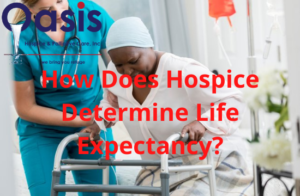Oasis Hospice is the best hospice company. For more information and assistance call (708) 564-4838.
The predicted life expectancy of a patient affects the success of numerous medical interventions. When considering whether to initiate a specific treatment or provide a patient with a screening test, the majority of healthcare providers do not make an explicit calculation of life expectancy. The majority of practitioners make these judgments using inferential reasoning. While physicians’ survival forecasts are significantly connected with actual survival, physicians tend to overestimate survival. To qualify for Medicare-covered hospice, a physician must certify that the patient is anticipated to die within six months. Many healthcare providers hesitate and postpone initiating hospice care due to their lack of confidence in their competence to make this assessment. Additionally, healthcare providers are hesitant to specify the appropriate time for distant relatives and friends to pay a final visit to a dying patient. Again, providers are anxious about making incorrect judgments. Life expectancy estimates significantly impact medical practice in long-term care (LTC) settings. A growing body of data is now available to assist healthcare professionals in making a more accurate judgment.

Life Expectancy in the Long Run
When a patient has metastatic lung cancer, most healthcare practitioners will not prescribe bisphosphonates for osteoporosis treatment. However, should bisphosphonate be provided to an 85-year-old patient with osteoporosis and no apparent life-threatening illness? Does hospice determine life expectancy?
To deliver an informed response to this question, the healthcare provider must follow several steps (described below):
- Evaluate the patient’s life expectancy.
- Determine the duration of drug treatment necessary to achieve a benefit.
- Determine whether the use is clinically relevant.
Additional considerations include adverse effects and costs. Determining whether to discontinue disease screening involves a similar analysis.
Step 1: Life Expectancy Calculation
Age, disease, and handicap all affect life expectancy. Tables of life expectancy at various ages provide years of life expectancy based on all-cause mortality. While age is a significant predictor of mortality, and sickness also plays a role. For some conditions, such as malignancies and congestive heart failure, disease-related mortality is well described, but not for others (e.g., Alzheimer’s disease). Diverse diseases have varying effects on mortality. Lung cancer has a significant impact; macular degeneration has a negligible effect. Frailty and disability can play an essential role in higher mortality. Dependence on dressing and toileting has been associated with an increased risk of death. The index predicts mortality using age, gender, disease, and function. According to this Index, an 80-year-old lady with a score of 10 or higher has a nearly 80% 4-year mortality rate. You should also look for hospice companies near me.
Step 2. How Long Will the Intervention Take to Take Effect?
The time required for medical intervention to have an effect may be readily apparent (e.g., using an antibiotic to treat a urinary tract infection). Alternatively, it may be less noticeable (e.g., bisphosphonate reduces subsequent bone fractures). Numerous clinical trials examining the efficacy of bisphosphonates followed patients for a minimum of three years. In one such test, women over the age of 80 with osteoporosis treated with risedronate for three years had a considerably lower fracture risk. The healthcare provider must be aware of clinical advice based on clinical trials and the research methods used.
Step 3. Is the Result Clinically Significant?
A statistically significant outcome does not always translate into a clinically meaningful difference in a clinical trial. Knowing the number of patients that require treatment to avoid a single adverse result can aid the doctor in deciding whether to prescribe a specific intervention. In the risedronate research, twelve women required treatment to prevent one fracture. The character of the outcome is also critical: Bisphosphonates may help prevent height loss, vertebral fractures, and femoral fractures, a series of occurrences with varying degrees of clinical relevance.
Life Expectancy in the Mid-Term (less than six mo)
A physician must certify that the patient is expected to die within six months before accessing the Medicare Hospice Benefit. Cancer is a common reason for patients to enter hospice care. However, most cancer mortality estimates are expressed as a percentage of patients who survive five or ten years after diagnosis, which is ineffective for predicting mortality within six months. There are, however, some general and disease-specific statistics and prediction methods that can assist the practitioner in determining with greater accuracy whether the patient’s life expectancy is six months or less. Heart failure is a leading cause of death in the elderly.
The four-item risk score of 30 mg/dL or above serum urea nitrogen, less than 120 mmHg systolic blood pressure, peripheral arterial disease, and less than 135 mEq/L serum sodium was found to be an excellent predictor of death from congestive heart failure at six months.
More than two-thirds of patients with three or more risk indicators will die within six months, according to this measure. Alzheimer’s disease is a leading cause of death among nursing home residents. The Functional Assessment Staging Test (FAST) is a tool for tracking the course of dementia (https://www.mccare.com/pdf/support/product/fast Overview.pdf). Over two-thirds of individuals with dementia stage 7C or higher will die within six months. Hospice care should normally be considered at stage 7C or greater. However, it is critical to remember that not all patients with dementia proceed through the disease in the manner outlined by the FAST.
It has been demonstrated to be an effective predictor of 6-month death, particularly in nursing home residents. 96 percent of individuals with a PPS score of 10-20 died within six months, according to one study. The PPS should be familiar to all providers of long-term care. Nursing homes should consider utilizing this tool to assist them in determining when palliative and hospice care should be commenced.
Life Expectancy in the Short Term (days)
Providers of long-term care are frequently asked to forecast death within several days of it occurring so that family members and friends can travel to see the patient before he or she dies. Extremely low PPS scores can predict imminent death within a week or less. If an already fragile and unwell patient stops taking liquids and is not given artificial hydration, death is likely within days, however, some patients may survive for a week or two. Cheynes-Stokes respiration or prolonged bouts of apnea are usually indicators of imminent mortality in an elderly unwell patient. It is critical to emphasize to patients and families the difficulty of predicting imminent death. Family and friends may wish to see a dying loved one prior to the patient losing consciousness, which frequently occurs days or weeks before death. The majority of doctors will rely on their experience when responding to difficult queries about life expectancy. However, people who are frequently relied upon to make these choices should familiarise themselves with objective tools that can assist. Numerous disease prevention guidelines now recommend suspending a screening test or intervention only if the patient’s life expectancy is less than a specified number of years. Patients’ or legal guardians’ wishes are crucial components of the decision-making process, particularly when a patient or legal guardian declines a suggested therapy. In one study, the estimated life expectancy and predicted quality of life with and without the intervention influenced a patient’s decision to have a ventricular assistive device put to treat severe heart failure.

